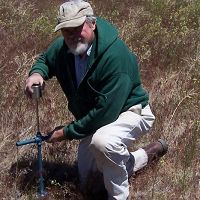Hunsaker & Johnson, 2017
Concentration-discharge relationships in headwater streams of the Sierra Nevada, California
Hunsaker, C. T., Johnson, D. W. (2017)
Water Resources Research 53, 7869–7884
-
Sierra, INVESTIGATOR
-
Sierra, INVESTIGATOR
Abstract
We examined stream water concentration-discharge relationships for eight small, forest watersheds ranging in elevation from 1485 to 2465 m in the southern Sierra Nevada. These headwater streams revealed nearly chemostatic behavior by current definitions for K+, Ca2+, Mg2+, Na+, Cl–, and math formula in most cases but not for math formula, math formula, or ortho-P. The latter ions were somewhat enriched during high flows. All ions studied showed a dilution process at lower flows (<50 L s−1) with the concentration-discharge relationship being more chemostatic at higher flows. While previous studies in the Sierra Nevada have reported peak concentrations of math formula, math formula, and math formula during snowmelt, the headwater systems of the Kings River Experimental Watersheds experience peak concentrations of these ions during the fall rains after the dry summer. These forested watersheds span the rain-snow transition zone, are 49–228 ha in size, and have soils derived from granite. A statistically significant relationship between soils and stream water concentrations for ortho-P, Ca2+, and Na+ strongly suggests that soil chemistry has a major influence on stream water chemistry. Factors controlling stream water math formula, math formula, and math formula concentrations are less clear, but one possible source of spikes in these ions during storm events is input from O-horizon runoff where high concentrations were measured. Overall, stream water concentration-discharge relationships for these Sierran watersheds are similar to those found in other watershed systems (nearly chemostatic); however, the dominant processes controlling these relationships are probably localized because of different watershed characteristics like soil chemistry, vegetation cover, hydrologic flow paths, and weather patterns.
Citation
Hunsaker, C. T., Johnson, D. W. (2017): Concentration-discharge relationships in headwater streams of the Sierra Nevada, California. Water Resources Research 53, 7869–7884.
 This Paper/Book acknowledges NSF CZO grant support.
This Paper/Book acknowledges NSF CZO grant support.
Explore Further


